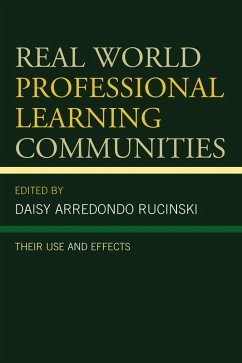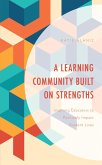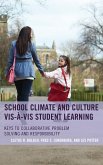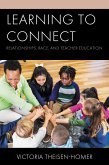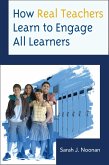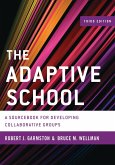Daisy Arredondo Rucinski
Real World Professional Learning Communities (eBook, PDF)
Their Use and Effects
26,95 €
26,95 €
inkl. MwSt.
Sofort per Download lieferbar

13 °P sammeln
26,95 €
Als Download kaufen

26,95 €
inkl. MwSt.
Sofort per Download lieferbar

13 °P sammeln
Jetzt verschenken
Alle Infos zum eBook verschenken
26,95 €
inkl. MwSt.
Sofort per Download lieferbar
Alle Infos zum eBook verschenken

13 °P sammeln
Daisy Arredondo Rucinski
Real World Professional Learning Communities (eBook, PDF)
Their Use and Effects
- Format: PDF
- Merkliste
- Auf die Merkliste
- Bewerten Bewerten
- Teilen
- Produkt teilen
- Produkterinnerung
- Produkterinnerung

Bitte loggen Sie sich zunächst in Ihr Kundenkonto ein oder registrieren Sie sich bei
bücher.de, um das eBook-Abo tolino select nutzen zu können.
Hier können Sie sich einloggen
Hier können Sie sich einloggen
Sie sind bereits eingeloggt. Klicken Sie auf 2. tolino select Abo, um fortzufahren.

Bitte loggen Sie sich zunächst in Ihr Kundenkonto ein oder registrieren Sie sich bei bücher.de, um das eBook-Abo tolino select nutzen zu können.
In a professional learning community (PLC), teachers are organized into teams, committed to meeting on a regular basis to study their teaching strategies and the effects of those strategies on the students in their classrooms. The teacher teams can be of varied form and composition. Whatever the organizational structure, the teams have one goal - that is to improve teaching so that student learning is improved. Policy developers, legislators, and educational leaders have encouraged the adoption of collaborative professional learning teams as a school reform model for improving schools. In this…mehr
- Geräte: PC
- mit Kopierschutz
- eBook Hilfe
- Größe: 1.6MB
Andere Kunden interessierten sich auch für
![A Learning Community Built on Strengths (eBook, PDF) A Learning Community Built on Strengths (eBook, PDF)]() Katie AlanizA Learning Community Built on Strengths (eBook, PDF)19,95 €
Katie AlanizA Learning Community Built on Strengths (eBook, PDF)19,95 €![School Climate and Culture vis-à-vis Student Learning (eBook, PDF) School Climate and Culture vis-à-vis Student Learning (eBook, PDF)]() Cletus R. BulachSchool Climate and Culture vis-à-vis Student Learning (eBook, PDF)22,95 €
Cletus R. BulachSchool Climate and Culture vis-à-vis Student Learning (eBook, PDF)22,95 €![Learning to Connect (eBook, PDF) Learning to Connect (eBook, PDF)]() Victoria Theisen-HomerLearning to Connect (eBook, PDF)21,95 €
Victoria Theisen-HomerLearning to Connect (eBook, PDF)21,95 €![How Real Teachers Learn to Engage All Learners (eBook, PDF) How Real Teachers Learn to Engage All Learners (eBook, PDF)]() Sarah J. NoonanHow Real Teachers Learn to Engage All Learners (eBook, PDF)37,95 €
Sarah J. NoonanHow Real Teachers Learn to Engage All Learners (eBook, PDF)37,95 €![The Adaptive School (eBook, PDF) The Adaptive School (eBook, PDF)]() Robert J. GarmstonThe Adaptive School (eBook, PDF)57,95 €
Robert J. GarmstonThe Adaptive School (eBook, PDF)57,95 €![Multimedia Learning Theory (eBook, PDF) Multimedia Learning Theory (eBook, PDF)]() Multimedia Learning Theory (eBook, PDF)23,95 €
Multimedia Learning Theory (eBook, PDF)23,95 €![Sketchnoting in School (eBook, PDF) Sketchnoting in School (eBook, PDF)]() Karin PerrySketchnoting in School (eBook, PDF)21,95 €
Karin PerrySketchnoting in School (eBook, PDF)21,95 €-
-
-
In a professional learning community (PLC), teachers are organized into teams, committed to meeting on a regular basis to study their teaching strategies and the effects of those strategies on the students in their classrooms. The teacher teams can be of varied form and composition. Whatever the organizational structure, the teams have one goal - that is to improve teaching so that student learning is improved. Policy developers, legislators, and educational leaders have encouraged the adoption of collaborative professional learning teams as a school reform model for improving schools. In this book we describe the results of studies of professional learning communities in real schools and the effects of the teams on student learning. Much of the time school innovations are not examined in depth. Instead authors and developers simply advocate that they be used. In this book, school principals and administrators describe how their teachers used the PLC teams to improve student learning in their schools. In other words, this book presents actual research on the effects of the use of PLCs rather than testimonials.
Produktdetails
- Produktdetails
- Verlag: Bloomsbury eBooks US
- Seitenzahl: 228
- Erscheinungstermin: 8. Dezember 2016
- Englisch
- ISBN-13: 9798216325772
- Artikelnr.: 74626173
- Verlag: Bloomsbury eBooks US
- Seitenzahl: 228
- Erscheinungstermin: 8. Dezember 2016
- Englisch
- ISBN-13: 9798216325772
- Artikelnr.: 74626173
- Herstellerkennzeichnung Die Herstellerinformationen sind derzeit nicht verfügbar.
Daisy Arredondo Rucinski is professor of educational leadership and policy studies at The University of Alabama, Tuscaloosa, AL. She holds a Ph.D. degree from the University of Washington. She has been a biology, Spanish, and algebra teacher, a high school assistant principal, an assistant superintendent for curriculum and instruction, a deputy superintendent, and a Senior Fulbright Scholar in Santiago, Chile. Her research interests are instructional leadership and supervision, professional development, school effectiveness, and reflective learning. She writes about these topics and related policy issues.
Foreword-Terri Croft Boman
Part I -Overview of book
Chapter 1: Introduction
Chapter 2: The Conceptual framework for Professional Learning Communities
as Reform Initiatives
Daisy Arredondo Rucinski (Example of use by Kyra L. Rhyne)
Part II - Use of PLCs in Elementary Schools
Chapter 3: Teacher reflection and teacher development in elementary schools
using Alabama's Instructional Partners Program (IPN)
Bradley A. Scott, Principal, Chaffee Elementary School, Huntsville, AL
Chapter 4: Elementary teacher reflection in professional learning
communities and teacher learning
Rachel Real Poovey - Supervisor of Elementary Education, Decatur, AL City
Schools
Chapter 5: Using PLC collaboration as a foundation for trust and teacher
efficacy in elementary schools
Datie I. Priest - Principal, West Decatur Elementary School, Decatur, AL
Part III - Use of PLCs in middle and high schools
Chapter 6: Relationships among professional learning communities, trust,
and student achievement in elementary and middle school mathematics.
Herbert A. Betts III - Madras Middle School, Assistant Principal, Coweta
School System, Newnan, GA
Chapter 7: School Culture, Professional Learning Community and Student
Achievement in Middle and High Schools
Amanda Hitson Cassity - District curriculum director, Northern Region,
Tuscaloosa County Schools, Tuscaloosa, AL
Chapter 8: Common Planning in High School Departments: A Structure for
Implementing Professional Learning Communities
Kyra L. Rhyne - District coordinator for virtual learning, Catoosa County
Schools, Ringold, GA
Part IV - School, District, and State contexts in using PLCs as a school
reform and accountability strategy:
Chapter 9: Using a professional learning community framework to support
response to intervention (RTI) in middle and high schools
Nicole Spiller - District Director of Student and Intervention Services,
Atlanta School System, Atlanta, GA
Chapter 10: Developing schools as professional learning communities: Does
district level leadership matter?
Terri Croft Boman - University - K-12 Professional Development Director
Chapter 11: Professional development in the states: How statutes and
regulations target teacher quality to improve student learning
Helen M. Hazi, Professor, West Virginia University and Daisy Arredondo
Rucinski - Professor, The University of Alabama
Part V - What the research says about the effects of using PLCs in schools
and student or teacher learning:
Chapter 12: Meta analyses of the research
Part 1: A meta-analytic review of dissertation research on Use of PLCs and
student achievement
Part 2: A Meta-analytic Review of the Published Research on Use of PLCs and
Student and Teacher Learning.
Susan McClendon Patrick, Secondary Curriculum Supervisor, Cullman County
Schools, Cullman, AL; Daisy Arredondo Rucinski, Professor; and Sara
Elizabeth Tomek, Associate Professor, UA.
Chapter 13: Conclusions, limitations, and implications for future research
Daisy Arredondo Rucinski
Index
Part I -Overview of book
Chapter 1: Introduction
Chapter 2: The Conceptual framework for Professional Learning Communities
as Reform Initiatives
Daisy Arredondo Rucinski (Example of use by Kyra L. Rhyne)
Part II - Use of PLCs in Elementary Schools
Chapter 3: Teacher reflection and teacher development in elementary schools
using Alabama's Instructional Partners Program (IPN)
Bradley A. Scott, Principal, Chaffee Elementary School, Huntsville, AL
Chapter 4: Elementary teacher reflection in professional learning
communities and teacher learning
Rachel Real Poovey - Supervisor of Elementary Education, Decatur, AL City
Schools
Chapter 5: Using PLC collaboration as a foundation for trust and teacher
efficacy in elementary schools
Datie I. Priest - Principal, West Decatur Elementary School, Decatur, AL
Part III - Use of PLCs in middle and high schools
Chapter 6: Relationships among professional learning communities, trust,
and student achievement in elementary and middle school mathematics.
Herbert A. Betts III - Madras Middle School, Assistant Principal, Coweta
School System, Newnan, GA
Chapter 7: School Culture, Professional Learning Community and Student
Achievement in Middle and High Schools
Amanda Hitson Cassity - District curriculum director, Northern Region,
Tuscaloosa County Schools, Tuscaloosa, AL
Chapter 8: Common Planning in High School Departments: A Structure for
Implementing Professional Learning Communities
Kyra L. Rhyne - District coordinator for virtual learning, Catoosa County
Schools, Ringold, GA
Part IV - School, District, and State contexts in using PLCs as a school
reform and accountability strategy:
Chapter 9: Using a professional learning community framework to support
response to intervention (RTI) in middle and high schools
Nicole Spiller - District Director of Student and Intervention Services,
Atlanta School System, Atlanta, GA
Chapter 10: Developing schools as professional learning communities: Does
district level leadership matter?
Terri Croft Boman - University - K-12 Professional Development Director
Chapter 11: Professional development in the states: How statutes and
regulations target teacher quality to improve student learning
Helen M. Hazi, Professor, West Virginia University and Daisy Arredondo
Rucinski - Professor, The University of Alabama
Part V - What the research says about the effects of using PLCs in schools
and student or teacher learning:
Chapter 12: Meta analyses of the research
Part 1: A meta-analytic review of dissertation research on Use of PLCs and
student achievement
Part 2: A Meta-analytic Review of the Published Research on Use of PLCs and
Student and Teacher Learning.
Susan McClendon Patrick, Secondary Curriculum Supervisor, Cullman County
Schools, Cullman, AL; Daisy Arredondo Rucinski, Professor; and Sara
Elizabeth Tomek, Associate Professor, UA.
Chapter 13: Conclusions, limitations, and implications for future research
Daisy Arredondo Rucinski
Index
Foreword-Terri Croft Boman
Part I -Overview of book
Chapter 1: Introduction
Chapter 2: The Conceptual framework for Professional Learning Communities
as Reform Initiatives
Daisy Arredondo Rucinski (Example of use by Kyra L. Rhyne)
Part II - Use of PLCs in Elementary Schools
Chapter 3: Teacher reflection and teacher development in elementary schools
using Alabama's Instructional Partners Program (IPN)
Bradley A. Scott, Principal, Chaffee Elementary School, Huntsville, AL
Chapter 4: Elementary teacher reflection in professional learning
communities and teacher learning
Rachel Real Poovey - Supervisor of Elementary Education, Decatur, AL City
Schools
Chapter 5: Using PLC collaboration as a foundation for trust and teacher
efficacy in elementary schools
Datie I. Priest - Principal, West Decatur Elementary School, Decatur, AL
Part III - Use of PLCs in middle and high schools
Chapter 6: Relationships among professional learning communities, trust,
and student achievement in elementary and middle school mathematics.
Herbert A. Betts III - Madras Middle School, Assistant Principal, Coweta
School System, Newnan, GA
Chapter 7: School Culture, Professional Learning Community and Student
Achievement in Middle and High Schools
Amanda Hitson Cassity - District curriculum director, Northern Region,
Tuscaloosa County Schools, Tuscaloosa, AL
Chapter 8: Common Planning in High School Departments: A Structure for
Implementing Professional Learning Communities
Kyra L. Rhyne - District coordinator for virtual learning, Catoosa County
Schools, Ringold, GA
Part IV - School, District, and State contexts in using PLCs as a school
reform and accountability strategy:
Chapter 9: Using a professional learning community framework to support
response to intervention (RTI) in middle and high schools
Nicole Spiller - District Director of Student and Intervention Services,
Atlanta School System, Atlanta, GA
Chapter 10: Developing schools as professional learning communities: Does
district level leadership matter?
Terri Croft Boman - University - K-12 Professional Development Director
Chapter 11: Professional development in the states: How statutes and
regulations target teacher quality to improve student learning
Helen M. Hazi, Professor, West Virginia University and Daisy Arredondo
Rucinski - Professor, The University of Alabama
Part V - What the research says about the effects of using PLCs in schools
and student or teacher learning:
Chapter 12: Meta analyses of the research
Part 1: A meta-analytic review of dissertation research on Use of PLCs and
student achievement
Part 2: A Meta-analytic Review of the Published Research on Use of PLCs and
Student and Teacher Learning.
Susan McClendon Patrick, Secondary Curriculum Supervisor, Cullman County
Schools, Cullman, AL; Daisy Arredondo Rucinski, Professor; and Sara
Elizabeth Tomek, Associate Professor, UA.
Chapter 13: Conclusions, limitations, and implications for future research
Daisy Arredondo Rucinski
Index
Part I -Overview of book
Chapter 1: Introduction
Chapter 2: The Conceptual framework for Professional Learning Communities
as Reform Initiatives
Daisy Arredondo Rucinski (Example of use by Kyra L. Rhyne)
Part II - Use of PLCs in Elementary Schools
Chapter 3: Teacher reflection and teacher development in elementary schools
using Alabama's Instructional Partners Program (IPN)
Bradley A. Scott, Principal, Chaffee Elementary School, Huntsville, AL
Chapter 4: Elementary teacher reflection in professional learning
communities and teacher learning
Rachel Real Poovey - Supervisor of Elementary Education, Decatur, AL City
Schools
Chapter 5: Using PLC collaboration as a foundation for trust and teacher
efficacy in elementary schools
Datie I. Priest - Principal, West Decatur Elementary School, Decatur, AL
Part III - Use of PLCs in middle and high schools
Chapter 6: Relationships among professional learning communities, trust,
and student achievement in elementary and middle school mathematics.
Herbert A. Betts III - Madras Middle School, Assistant Principal, Coweta
School System, Newnan, GA
Chapter 7: School Culture, Professional Learning Community and Student
Achievement in Middle and High Schools
Amanda Hitson Cassity - District curriculum director, Northern Region,
Tuscaloosa County Schools, Tuscaloosa, AL
Chapter 8: Common Planning in High School Departments: A Structure for
Implementing Professional Learning Communities
Kyra L. Rhyne - District coordinator for virtual learning, Catoosa County
Schools, Ringold, GA
Part IV - School, District, and State contexts in using PLCs as a school
reform and accountability strategy:
Chapter 9: Using a professional learning community framework to support
response to intervention (RTI) in middle and high schools
Nicole Spiller - District Director of Student and Intervention Services,
Atlanta School System, Atlanta, GA
Chapter 10: Developing schools as professional learning communities: Does
district level leadership matter?
Terri Croft Boman - University - K-12 Professional Development Director
Chapter 11: Professional development in the states: How statutes and
regulations target teacher quality to improve student learning
Helen M. Hazi, Professor, West Virginia University and Daisy Arredondo
Rucinski - Professor, The University of Alabama
Part V - What the research says about the effects of using PLCs in schools
and student or teacher learning:
Chapter 12: Meta analyses of the research
Part 1: A meta-analytic review of dissertation research on Use of PLCs and
student achievement
Part 2: A Meta-analytic Review of the Published Research on Use of PLCs and
Student and Teacher Learning.
Susan McClendon Patrick, Secondary Curriculum Supervisor, Cullman County
Schools, Cullman, AL; Daisy Arredondo Rucinski, Professor; and Sara
Elizabeth Tomek, Associate Professor, UA.
Chapter 13: Conclusions, limitations, and implications for future research
Daisy Arredondo Rucinski
Index
